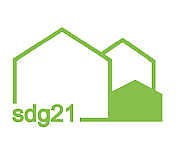12/2012: NABU Negative Award goes to Ilse Aigner
www.nabu.de/aktionenundprojekte/dinodesjahres
11/2012: Europe's tallest cross laminated timber skyscrapers with nine floors currently in Milan
www.proholz.at/...mailand...
Research project "PlusEnergyQuartier Oberursel" with about 150 apartments and commercial use starts
www.fr-online.de/...oberursel
10/2012: Built Environment release "Co-Housing in the Making“
The current issue of the English-language journal "Built Environment" deals with communal living on an international level. Authors from Finland, Sweden, Great Britain, Germany, the United States and the Netherlands deal with different aspects of communal living or "co-housing".
Issue reference: www.alexandrinepress.co.uk
10/2012: The most sustainable cities and municipalities of the German Sustainability Award 2012
www.difu.de/...deutscher-nachhaltigkeitspreis-2012...
10/2012: Solar cell record with 44% efficiency
www.solarserver.com/...world-record-solar-cell...
9/2012: IBA Hamburg's BIQ - Microalgae Building
The innovative project in Hamburg Wilhelmsburg is the first house in the world to supply itself with energy via a building façade made of photovoltaic collectors. The flexible interior design also sets standards for the urban life of the future
www.biq-wilhelmsburg.de
8/2012: Climate protection in municipalities: practical guide
The practical guide was funded by the Federal Ministry for the Environment, Nature Conservation and Nuclear Safety (BMU) and developed by the German Institute of Urban Affairs (Difu) in cooperation with the Institute for Energy and Environmental Research (ifeu) and Climate Alliance. Difu was responsible for project management and leadership.
The guide, which was already published in 1997, was fundamentally revised in terms of content and structure due to the lively demand from municipalities throughout the Federal Republic and supplemented with current focal points and fields of action. The new guide once again contains numerous current practical examples that are intended to motivate local authorities to emulate or undertake their own climate protection activities.
www.leitfaden.kommunaler-klimaschutz.de
7/2012: On the website www.informationsdienst-holz.de information about planning and building with wood will be available again.
7/2012: Research team from Freiburg introduces natural hard foams from bark extract here:
www.pr.uni-freiburg.de/...
6/2012: Flagship project "Hamburg Water Cycle"In 770 residential units for approx. 2,000 inhabitants, toilet wastewater (black water) and other domestic wastewater (grey water) is discharged separately. The black water is collected in concentrated form via vacuum toilets with negative pressure technology and converted into biogas together with organic waste in a biogas plant:
www.hamburgwatercycle.de/...jenfelder-au
Past the need: 50,000 square meters of unletable office space in Hamburg's HafenCity
www.spiegel.de/...hamburgs-hafencity
5/2012: 20,000 MW output from German solar plants for the first time
www.iwrpressedienst.de/...
4/2012: Subsidy programmes for energy-efficient construction and refurbishment in full. The Budget Committee of the German Bundestag has released the full amount of funds for the CO2 Building Rehabilitation Programmes for 2012. This means that EUR 1.5 billion per year will be available for the KfW programmes from 2012 to 2014:
www.eco-info.de/...
3/2012: Leitfaden Nachhaltigkeitsorientierte Architekturwettbewerbe. Published by: Free Hanseatic City of Hamburg 2011
www.hamburg.de/lena
2/2012: Damien Hirst invests in 500 eco-homes in southern England
This was reported by various newspapers. According to the report, the houses will be equipped with wind turbines on the roofs, solar panels and state-of-the-art insulation technology. Hirst hopes that the settlement will become a model for sustainable living and a sustainable development of the region. In Devon, the 46-year-old artist already runs a restaurant, a studio and owns several properties. The estate's architect comes pen-led by Mike Rundell of London-based MRJ Rundell + Associates, Architects and Designers. Construction work on the 32-hectare site near Killacleave is due to start in 2013.
2/2012: Reference book "50 Solar Housing Estates in North Rhine-Westphalia". Published
www.energieagentur.nrw.de/solarsiedlungen/page.asp?InfoID=11022
1/2012: Largest Swiss timber construction in Minergie-P Eco construction, car-free living concept and multi-generation living in Oberwinterthur under construction
www.giesserei-gesewo.ch
1/2012: German construction booming in 2011 - 2012 no longer
The construction industry expects sales to grow by 1.0 percent in real terms in 2012. Following a boom year in 2011, the main construction industry association is now preparing its members for a difficult year in an uncertain overall economic environment.
www.heute.de/...
Keywords:
DE-News

